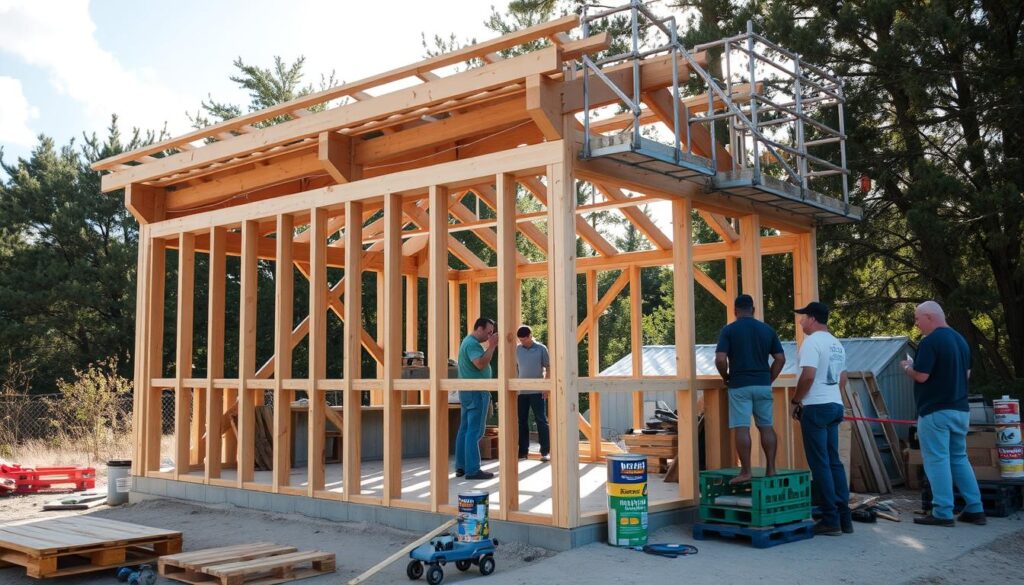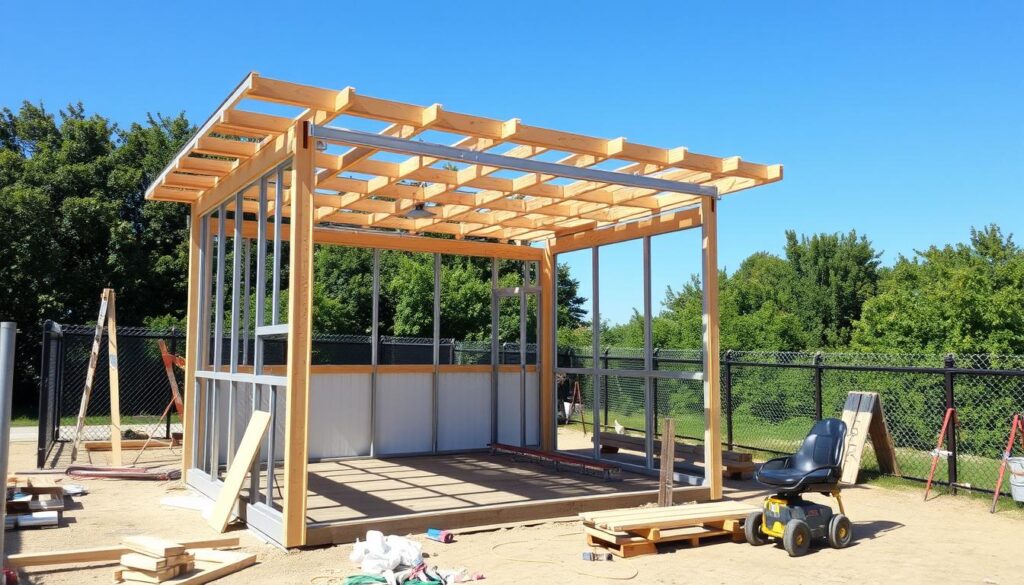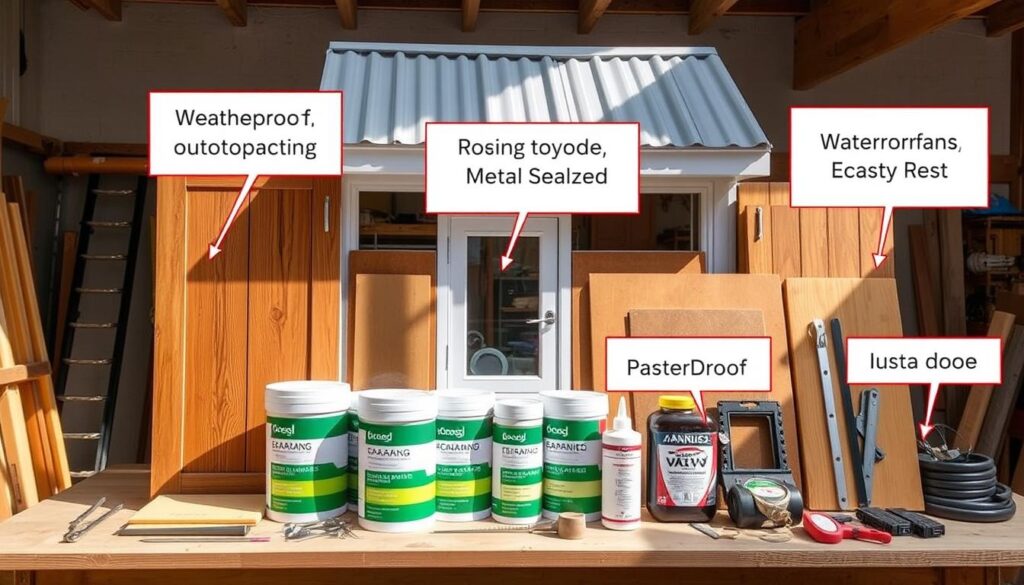Building an outdoor kiosk needs careful thought about size, device choice, and weather protection. It’s key to think about what your project needs. This guide will help you build an outdoor kiosk, covering important points and giving expert advice for success.
Learning to build outdoor kiosks means focusing on durability and function. You need to pick the right materials, design well, and use the right building methods. By following this guide, you can make a strong and useful outdoor kiosk, whether you’re running a business or managing facilities.

Knowing how to build an outdoor kiosk is vital for its long-term success. You must think about sun and moisture, which can be issues. By planning and designing your kiosk well, you can make a valuable spot for your customers or users.
Key Takeaways
- Outdoor kiosk construction requires careful consideration of size, device selection, and exposure to elements.
- Durability and functionality are essential for a successful outdoor kiosk.
- Material selection, design, and construction techniques are critical factors in outdoor kiosk construction.
- Understanding building an kiosk involves considering factors such as sun and moisture.
- A well-planned and designed outdoor kiosk can provide long-term value for customers or users.
- Learning how to build an outside kiosk involves staying up-to-date on the latest construction techniques and technologies.
Essential Planning Considerations for Building Your Outdoor Kiosk Project
Building an outdoor kiosk requires careful planning. You need to think about what will make it work well and last long. Outdoor kiosk design ideas and outdoor kiosk building tips can help you plan.
Important things to think about include power, internet, weather resistance, and security. For example, outdoor digital signs need cables for power and internet. Also, screens should be very bright, 2,500 Nits, to be seen in sunlight.
Here are some key factors to consider when planning your outdoor kiosk project:
- Location assessment and permitting requirements
- Budget planning and cost estimation
- Timeline development
By carefully evaluating these factors and using outdoor kiosk design ideas and outdoor kiosk building tips, you can make a detailed plan. This ensures your kiosk works well, lasts long, and meets your needs.
Don’t forget to think about the environment too. Consider ground-works, power and data cabling, and anti-rust measures. A well-planned approach will help you create a successful outdoor kiosk that users will enjoy.
| Factor | Consideration |
|---|---|
| Location | Assess foot traffic, visibility, and accessibility |
| Budget | Estimate costs for materials, labor, and maintenance |
| Timeline | Develop a realistic project schedule |
Selecting Weather-Resistant Materials
Choosing the right materials for an outdoor kiosk is key for its durability. It must withstand harsh weather like extreme temperatures and humidity. Outdoor kiosk materials should keep the kiosk looking good and working well.
For a diy outdoor kiosk, picking the right materials is essential. Stainless steel, powder-coated aluminum, and high-grade plastics are good choices. They resist weather, corrosion, and extreme temperatures well.
When picking materials for an outdoor kiosk, consider these:
- Weather resistance: Can the material handle rain, snow, and extreme temperatures?
- Corrosion resistance: Will it corrode or break down over time when wet?
- Durability: Can it handle heavy use and possible vandalism?
Choosing the right materials ensures your outdoor kiosk lasts long and looks great. Whether you’re doing it yourself or hiring a pro, picking the right materials is vital. It can make your project a success.
Design Elements for a Functional Outdoor Kiosk
When designing an outdoor kiosk, several key elements must be considered. Outdoor kiosk design ideas should focus on accessibility, security, and weather protection. Materials like steel frames, wood, and tempered glass are great for building a strong and lasting structure.
Some essential features to include in your outdoor kiosk design are:
- Steel frames for strength and reliability
- Wood for natural beauty and adaptability
- Tempered glass for durability and resistance to scratching or cracking
Also, think about how to build an outdoor kiosk that meets specific needs. For example, food kiosks might need stainless steel counters to resist corrosion. By adding these design elements, you can make a functional and attractive outdoor kiosk that improves the area around it.
To fully understand outdoor kiosk design, consider material selection, security features, and weather protection. This way, you can build an exterior kiosk that is both useful and looks good. It will meet the needs of users and make their experience better.
| Material | Benefits |
|---|---|
| Steel frames | Strength, reliability, and resistance to rust |
| Wood | Natural beauty, adaptability, and durability |
| Tempered glass | Durability, resistance to scratching or cracking, and aesthetic appeal |
How to Build Outdoor Kiosks: Step-by-Step Construction Process
Building an outdoor kiosk requires careful planning. You need to pick the right materials, build it off-site, and then assemble it on location. Making sure it’s sturdy and well-aligned is key to its long life.
First, prepare the site by digging and laying a foundation if needed. Then, build the kiosk frame and add weatherproofing. Don’t forget to install display screens and hardware correctly. It’s also important to make sure the kiosk is stable and easy to maintain.
Some important things to think about when building an outdoor kiosk include:
- Choose materials that can handle bad weather, like fiberglass or polyethylene
- Add security features, like strong locks and anchoring the kiosk
- Make sure it’s safe for users, with smooth edges and slip-resistant surfaces
Keep your kiosk in good shape with regular checks. By following these steps and considering these points, you can create a strong and useful outdoor kiosk.

| Kiosk Feature | Importance |
|---|---|
| Weatherproofing | High |
| Security Measures | High |
| User Safety Features | High |
Electrical and Technical Infrastructure
Building an outdoor kiosk means thinking about its electrical and technical needs. A good guide should cover power, network, and climate control. These elements help your kiosk work well and last long.
Choosing the right power source is key. You might use solar or traditional power. Make sure all electrical parts can handle the weather. Also, grounding is important for safety and reliability.
Network connectivity is also critical. You can use wires or wireless tech, depending on your needs. Good network solutions help with communication and data.
| Component | Description |
|---|---|
| Power Supply | Selection of power source and installation of weather-resistant electrical components |
| Network Connectivity | Provision of hardwired or wireless options for data transmission |
| Climate Control | Installation of heating, cooling, and humidity control systems to maintain optimal operating conditions |
Follow these tips to build a solid electrical and technical base for your kiosk. This will help it succeed in the long run.
Weatherproofing and Protection Measures
Building an outdoor kiosk means you must think about weatherproofing. The right materials and tips can help your kiosk last longer and work better. Use weatherproof paints, powder coats, and make sure it has good ventilation.
Water channels are key to stop water from pooling and causing rust. Choose materials with IP ratings like IP54 or IP55 for water and dust protection. NEMA ratings like NEMA 4X or 6P show it can handle different weather conditions.

- Implementing security measures like strong locks, surveillance cameras, and alarm systems
- Utilizing displays with adaptive features that automatically adjust brightness
- Incorporating a solar shield to protect screens from direct sunlight
- Choosing media players that offer a wide variety of formats
Follow these tips and use the right materials for your kiosk. This way, it will stay functional and safe in many weather conditions. Good weatherproofing and protection can make your kiosk last longer.
| IP Rating | Protection Level |
|---|---|
| IP54 | Protection against dust and water spray |
| IP55 | Protection against dust and low-pressure water jets |
| IP65 | Protection against dust and low-pressure water jets from any direction |
Quality Assurance and Testing Procedures
Ensuring your outdoor kiosk is of high quality and safe is key to its success. A good outdoor kiosk project guide should cover quality checks and tests. This is vital for a DIY outdoor kiosk to ensure it works well and meets standards.
Important steps include structural integrity checks, systems testing protocol, and safety compliance verification. These steps help find any problems early. They make sure your kiosk is reliable, efficient, and easy to use.
Here are some steps to follow for quality assurance and testing:
- Conduct thorough weatherproofing tests to ensure your kiosk can withstand various environmental conditions.
- Perform electrical safety checks and verify adherence to ADA guidelines.
- Test all electronic components, including display screens, input devices, and network connections.
By following these steps, you’ll be sure your outdoor kiosk is reliable and safe. Always check a detailed outdoor kiosk project guide for more info on building and testing your DIY outdoor kiosk.
| Testing Procedure | Description |
|---|---|
| Structural Integrity Checks | Verify the kiosk’s stability and resistance to environmental stresses. |
| Systems Testing Protocol | Test all electronic components, including display screens, input devices, and network connections. |
| Safety Compliance Verification | Perform electrical safety checks and verify adherence to ADA guidelines. |
Conclusion: Ensuring Long-Term Success After Building Your Outdoor Kiosks
As we wrap up this guide on building an outdoor kiosk, it’s important to remember the key success factors. Proper planning, choosing the right materials, building it well, and regular upkeep are essential. By using the knowledge from this guide, you’ll make an outdoor kiosk that meets your needs now and in the future.
Having a solid maintenance plan is key to keeping your outdoor kiosk running smoothly for years. Regular checks, replacing parts, and updating software will keep your kiosk in top shape. This way, your investment stays safe, and customers keep having a great experience.
This guide has given you the tools to make your outdoor kiosk project a success. Whether you want to boost your brand, offer self-service, or save money, you’re ready. With the strategies and tips from this guide, you’ll create a durable, useful, and engaging outdoor kiosk. It will help your business succeed for a long time.
FAQ
What are the key factors to consider when planning an outdoor kiosk project?
When planning an exterior kiosk project, think about a few key things. First, assess the location and get the necessary permits. Next, plan your budget and estimate costs. Lastly, set a timeline for the project.
What types of weather-resistant materials are suitable for outdoor kiosk construction?
For outdoor kiosks, use materials that can handle tough weather. Stainless steel, powder-coated aluminum, and high-grade plastics are good choices. They can stand up to harsh conditions.
What design elements are important for a functional outdoor kiosk?
Designing a functional outdoor kiosk requires careful thought. Make sure it’s accessible and secure. Also, include weather protection to keep it usable and lasting.
What are the steps involved in the construction process for an outdoor kiosk?
Building an outdoor kiosk involves several steps. Start with site preparation. Then, assemble the kiosk frame. Next, add weatherproofing and install all components properly.
How can I ensure the electrical and technical infrastructure of my outdoor kiosk is reliable and efficient?
To ensure your kiosk’s electrical and technical systems work well, focus on a few areas. Set up a strong power supply. Use secure network connections. And, include climate control to keep things running smoothly.
What weatherproofing techniques are essential for protecting an outdoor kiosk?
To protect your kiosk from the weather, use a few key methods. Apply sealants and coatings to keep it dry. Use ventilation systems to control moisture. And, add drainage solutions to prevent water damage.
How can I ensure the quality and safety of my outdoor kiosk?
To ensure your kiosk is safe and reliable, follow a few steps. Conduct structural integrity checks. Test all systems. And, verify safety compliance to guarantee quality and safety.